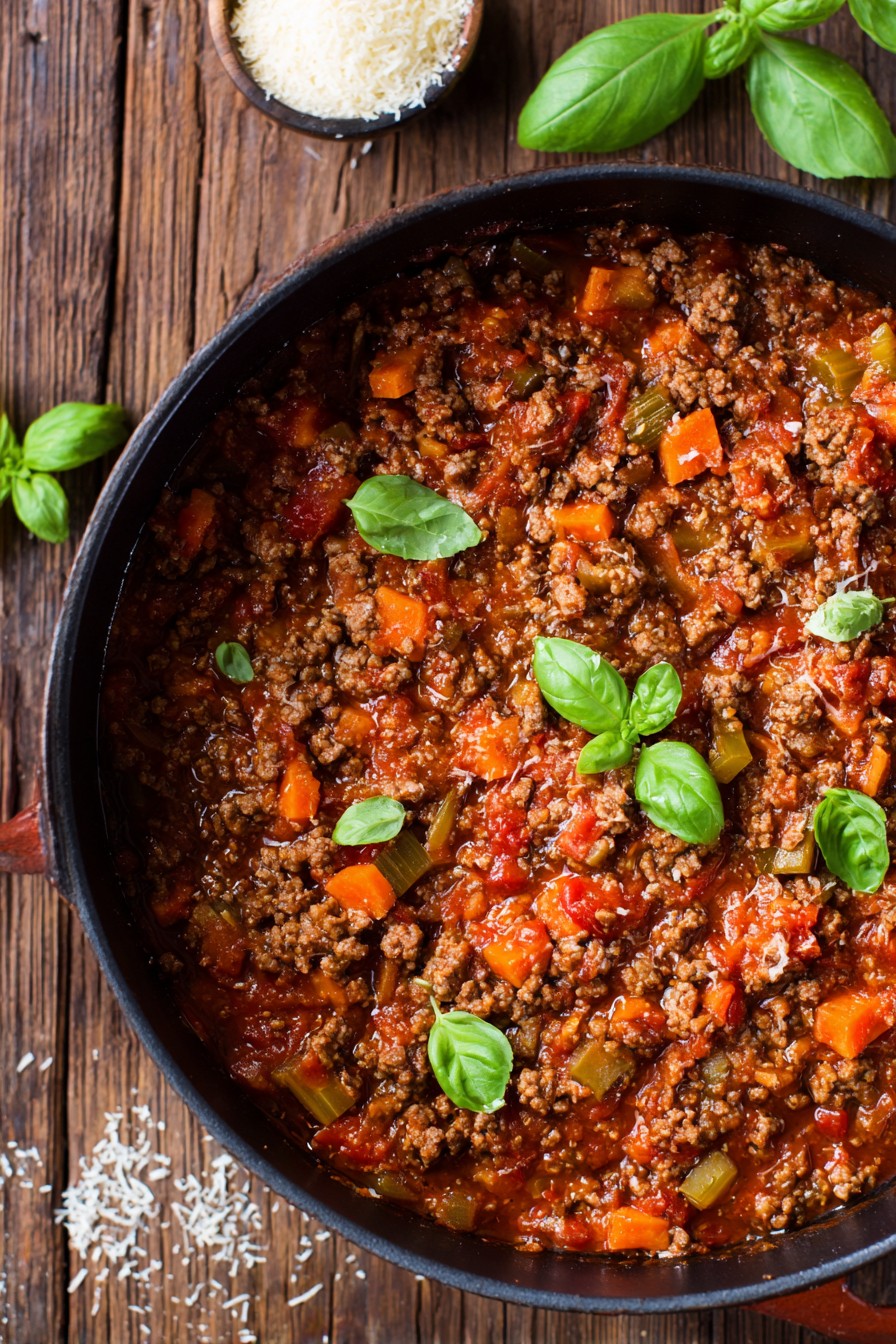Perfectly balancing convenience with culinary sophistication, this slow-cooked beef ragu transforms humble ground beef into an extraordinary meal through precise technique and patient simmering. Professional kitchens achieve depth of flavor through extended cooking times, and this recipe brings that same methodology to your home kitchen with the controlled environment of a crockpot.
Why This Recipe Works
- The initial high-heat sauté creates a proper Maillard reaction, developing complex flavor compounds that form the foundation of the dish
- Layering aromatics at specific intervals prevents flavor degradation while building a sophisticated flavor profile throughout the extended cooking process
- Using San Marzano tomatoes provides optimal acidity balance and superior texture due to their thinner skins and fewer seeds
- The extended low-temperature simmer allows collagen breakdown and flavor integration that cannot be rushed
- Finishing with fresh herbs and high-quality olive oil adds brightness and complexity that elevates the final presentation
Ingredients
- 2 pounds 80/20 ground beef
- 1 large yellow onion, finely diced (approximately 2 cups)
- 4 cloves garlic, minced
- 2 medium carrots, peeled and finely diced (approximately 1 cup)
- 2 celery ribs, finely diced (approximately 1 cup)
- 1 cup dry red wine (preferably Chianti or Cabernet Sauvignon)
- 1 (28-ounce) can San Marzano whole peeled tomatoes, crushed by hand
- 2 tablespoons tomato paste
- 4 cups beef stock, preferably homemade
- 2 bay leaves
- 1 teaspoon fresh thyme leaves
- 1/4 cup fresh basil, chopped
- 2 tablespoons extra virgin olive oil
- Kosher salt and freshly ground black pepper
- 1/2 cup grated Parmigiano-Reggiano cheese
Equipment Needed
- 6-quart slow cooker
- Large skillet or Dutch oven
- Wooden spoon or spatula
- Chef’s knife
- Cutting board
- Measuring cups and spoons
- Fine mesh strainer
Instructions

Initial Sauté and Flavor Foundation
Begin by heating 1 tablespoon of olive oil in a large skillet over medium-high heat until it shimmers and easily coats the surface. Add the ground beef in a single layer, resisting the urge to stir immediately to allow proper browning. After 3-4 minutes, use a wooden spoon to break the meat into coarse crumbles, continuing to cook until all pink coloration has disappeared and the beef develops a deep brown crust, approximately 8-10 minutes total. This Maillard reaction creates essential flavor compounds that form the foundation of your ragu. Season with 1 teaspoon kosher salt and 1/2 teaspoon black pepper during the final minute of cooking. Using a slotted spoon, transfer the beef to your slow cooker, leaving the rendered fat in the skillet for the next step.
Aromatic Vegetable Sauté
Add the remaining tablespoon of olive oil to the same skillet with the beef drippings and reduce heat to medium. Introduce the diced onions, carrots, and celery, stirring to coat in the fat. Cook for 8-10 minutes, stirring occasionally, until the vegetables have softened and the onions become translucent with slight golden edges. Add the minced garlic and cook for an additional 60 seconds until fragrant but not browned. The gradual softening of these aromatics releases their natural sugars and creates a sweet, complex base. Stir in the tomato paste and cook for 2 minutes, allowing it to darken slightly and lose its raw flavor. Deglaze the pan with the red wine, scraping all browned bits from the bottom, and reduce by half before transferring everything to the slow cooker.
Liquid Integration and Slow Cooking
Combine the hand-crushed San Marzano tomatoes, beef stock, bay leaves, and thyme with the beef and vegetable mixture in the slow cooker. Stir gently to incorporate all components without overmixing. The hand-crushed tomatoes provide superior texture control compared to pre-crushed varieties. Cover and set your slow cooker to low temperature for 8 hours, maintaining a consistent simmer where occasional bubbles break the surface but the liquid never reaches a rolling boil. This extended cooking time allows collagen breakdown and flavor integration that cannot be achieved through quicker methods. Avoid lifting the lid during the first 4 hours to maintain consistent temperature and moisture retention.
Final Texture Adjustment
After 8 hours, remove the bay leaves and assess the consistency of your ragu. If excess liquid remains, transfer the mixture to a saucepan and simmer uncovered for 15-20 minutes until the sauce thickens to your desired consistency, coating the back of a spoon without running off immediately. Alternatively, if using the slow cooker, remove the lid and continue cooking on high for 30-45 minutes. The ideal ragu should have a rich, thick consistency that holds its shape when spooned but isn’t pasty. Taste and adjust seasoning with additional salt and pepper as needed, remembering that flavors concentrate during reduction.
Finishing and Plating
Turn off the slow cooker and stir in the fresh basil and half of the grated Parmigiano-Reggiano cheese. Allow the ragu to rest for 10 minutes before serving to let the flavors meld and the cheese incorporate properly. The residual heat will wilt the basil perfectly without turning it bitter. Serve over freshly cooked pappardelle pasta or polenta, garnishing with the remaining cheese and a drizzle of high-quality extra virgin olive oil. The fat in the olive oil helps carry the flavors and adds a luxurious mouthfeel to the finished dish.
Tips and Tricks
For optimal flavor development, consider browning your ground beef in batches if your skillet cannot accommodate all 2 pounds in a single layer without steaming. Crowding the pan lowers the temperature too much, preventing proper Maillard reaction and resulting in gray, steamed meat rather than properly browned crumbles. When selecting your red wine for deglazing, choose a quality drinking wine rather than “cooking wine” – the flavor compounds concentrate during reduction, and inferior wines can introduce unwanted bitterness. For those seeking deeper umami characteristics, consider adding 2-3 dried porcini mushrooms that have been rehydrated in warm water; strain the liquid and add both the chopped mushrooms and the strained liquid to the slow cooker. If you prefer a smoother sauce texture, use an immersion blender to partially puree the ragu after cooking, being careful to maintain some textural variation. For meal prep efficiency, this ragu freezes exceptionally well for up to 3 months when stored in airtight containers, though I recommend adding fresh herbs after reheating. When serving, warm your plates beforehand to maintain the ideal serving temperature longer, as the fat in the ragu will solidify more quickly on cold surfaces. For dietary variations, you can substitute ground turkey or lamb, though cooking times may need adjustment based on fat content.
Recipe Variations
- Spicy Arrabbiata Style: Incorporate 1-2 teaspoons crushed red pepper flakes during the aromatic sauté stage, along with 1/4 cup chopped Calabrian chilies. Add 2 tablespoons of double-concentrated tomato paste for deeper tomato flavor and finish with fresh oregano instead of basil. The extended cooking time allows the capsaicin to mellow while maintaining its characteristic heat.
- Mushroom and Herb Infusion: Replace 1/2 pound of ground beef with 8 ounces of finely chopped cremini mushrooms sautéed separately until deeply browned. Add 2 tablespoons each of fresh rosemary and sage during the final hour of cooking, and use a mushroom-forward beef stock for enhanced earthiness.
- Mediterranean Twist: Incorporate 1/2 cup chopped Kalamata olives and 2 tablespoons capers during the last 30 minutes of cooking. Use white wine instead of red, and finish with fresh mint and lemon zest rather than basil. This variation pairs exceptionally well with orzo or couscous.
- Creamy Gorgonzola Finish: After the ragu has finished cooking, stir in 1/2 cup crumbled Gorgonzola cheese and 1/4 cup heavy cream during the final resting period. The blue cheese adds complexity while the cream creates a luxurious texture that complements the beef’s richness.
Frequently Asked Questions
Can I prepare this recipe on high heat for a shorter cooking time?
While technically possible to cook on high for 4-5 hours, I strongly recommend against it for quality reasons. The extended low-temperature cooking allows for proper collagen breakdown in the beef and gradual flavor development that cannot be rushed. High heat tends to toughen the meat fibers and doesn’t allow the same depth of flavor integration. The difference in texture and complexity is noticeable to experienced palates. If time is limited, consider preparing the recipe a day in advance as the flavors actually improve with overnight refrigeration.
What’s the purpose of hand-crushing the tomatoes versus using pre-crushed?
Hand-crushing San Marzano tomatoes provides superior control over texture and prevents the metallic taste that can come from machine-processing. The irregular pieces create a more interesting mouthfeel and allow the tomato pulp to break down gradually during cooking. Pre-crushed tomatoes often include calcium chloride to maintain firmness, which interferes with the natural breakdown process. Additionally, whole tomatoes are typically packed at their peak ripeness while crushed versions may include less ideal specimens. The extra minute of preparation makes a significant difference in the final product’s quality.
Can I substitute ground turkey or plant-based alternatives?
Ground turkey can be substituted with some adjustments – increase the olive oil to 3 tablespoons since turkey is leaner, and consider adding 1 tablespoon of soy sauce or Worcestershire sauce to enhance umami. For plant-based alternatives, crumbled tempeh or textured vegetable protein work well, though you’ll need to adjust cooking times downward to 4-5 hours on low since these proteins don’t require the same collagen breakdown. In both cases, monitor liquid levels more closely as alternative proteins may absorb moisture differently.
Why shouldn’t I add dairy earlier in the cooking process?
Adding dairy products like cheese or cream too early can cause curdling due to the extended exposure to heat and acidity from the tomatoes. The proteins in dairy denature and separate when subjected to prolonged cooking, resulting in an unpleasant grainy texture. Additionally, fresh herbs like basil lose their vibrant flavor and turn bitter when cooked for extended periods. These finishing elements are meant to provide brightness and contrast to the deep, developed flavors from the slow cooking process, so they should always be added at the end.
Summary
This sophisticated beef ragu demonstrates how proper technique transforms simple ingredients through controlled slow cooking. The methodical layering of flavors and patient simmering produces restaurant-quality results with minimal active effort, making it an ideal centerpiece for entertaining or family meals.
Slow-Cooked Beef Ragu
5
servings25
minutes8
minutesIngredients
Instructions
- 1 Brown ground beef in skillet with olive oil, season with salt and pepper, transfer to slow cooker
- 2 Sauté onions, carrots, celery, and garlic in same skillet, add tomato paste, deglaze with wine
- 3 Combine all ingredients in slow cooker except basil and cheese, cook on low for 8 hours
- 4 Adjust consistency by reducing if necessary, remove bay leaves
- 5 Stir in basil and half the cheese, rest 10 minutes before serving



